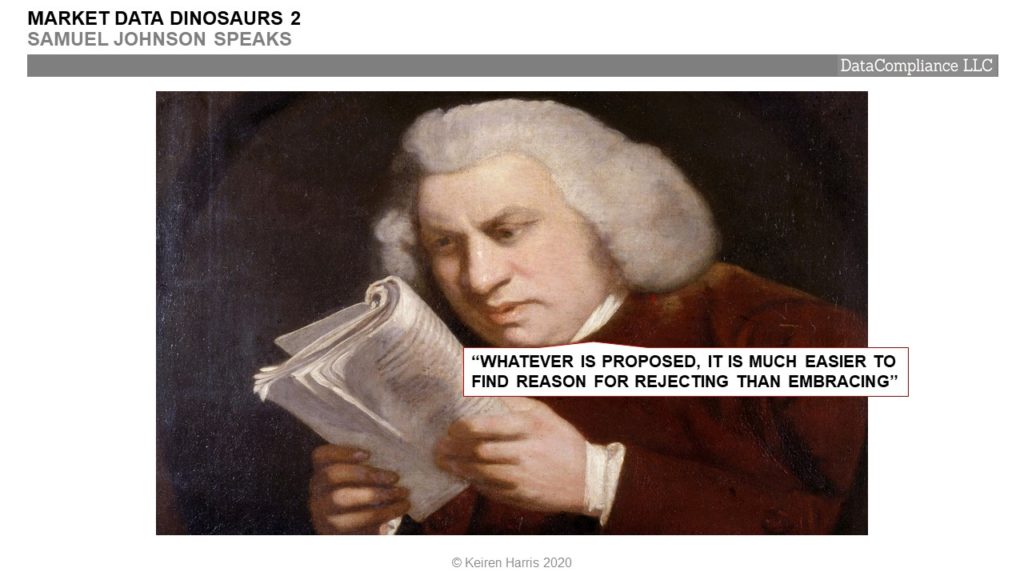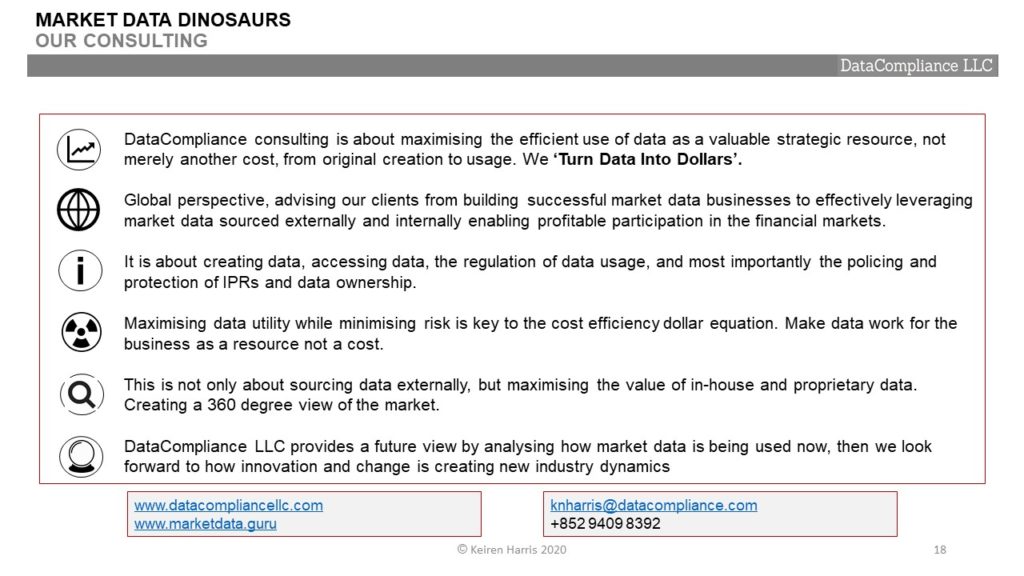FINTECH MAMMALS ARISE
In the second of our three articles we analyse the types of change our allegorical meteor will bring. As the business environment will change so do the rules governing its dynamics, and the one certain fact about new entrants to every industry is they perceive existing rules to a barrier, and want to work to change how an industry functions to increase their own chances of success.
Going forward, legacy market data vendors must not avoid making tough decisions, about what kind of vendors they are, exploiting relative strengths, eliminating inherent weaknesses, because what were once market barriers are now open gates. New competitors are neither what they seem, nor act as expected.
The new datacentric world is not one for altruism.
The data workflow revolution is on.
Specialisation, Data IP, Lightweight Tech in flexible environments the rulebreakers.
To read the first article please visit https://lnkd.in/gcpyRiA
STRENGTHS & WEAKNESSES
With the dinosaurs’ demise, life still went on, it was just in a different form, with the rise of the mammals. Small furry creatures once stuck in burrows, came out into the sunlight, prospered, grew to eventually become the new dominant life on earth.
There is always cause and effect, and the ability of the insurgent to take advantage of an incumbents’ weakness defines the eventual level of success. What were once strengths and barriers to entry have now become ‘Achilles’ Heels’.
In isolation the FinTechs are little more than an irritant to the large market data vendors, however, as a community (‘A Swarm of FinTechs?) they begin to complement and feed off each other. The sum of the parts then becomes greater in business value than what a vendor can aggregate. Working with lightweight tech and Data Malls outside the traditional market data system they bypass existing workflows to create their own, with unique rules, access points and omni-directional linkages.
The question for vendors then becomes ”How do I tap into this environment and leverage it for my benefit?”
Positive change, especially when older models still deliver but in declining efficiency, like for many market data vendors, is about the mental acuity to identify how things can be made to work better, and then have the willingness to act upon the motivation. At the moment the big vendors are good at talking about change, but are they doing anything about it?
Somehow I doubt there are many within the market data vendors who have read Dr. Samuel Johnson

To this end we must examine the 9 most immediate areas where the market data vendors are coming under pressure, what they are and what the impacts are proving to be.
As we have discussed the objective of all insurgents is to change the rules to benefit themselves, and if they benefit others that is more by luck than intention. So what ways rules are changing?
- Escaping the Infrastructure Prison. Vendor disintermediation, removal of expensive and soon to be redundant proprietary infrastructure. By disposing of the dependency upon vendors for data delivery, it simultaneously releases the Banks from the chains of costly old tech while opening up an array of data choices accessible via multiple channels not tied to one single vendor
- Increasing Shift to Multi-Access Distribution, i.e. In the Cloud. Choice brings the rise of the DataMalls, both by exchanges (ASX, CME, KOSCOM) and independents (MarketDesk), partners in data for FinTechs. They will act as an incentive to data diversity and reduce the vendors market share, even as the overall market grows
- Introduces New Open Access Standards. These breakdown proprietary barriers, weakening the vendors’ link between data source and data consumer by facilitating plug and play across multiple types of data, formats, and structures
- Data Differentiation. Access to Previously Off-Limits Specialist Data. Investors are looking for an edge by accessing data which their competitors have yet to find. By their nature, the universal aggregators eliminate this opportunity, along with an unwillingness to onboard new data sources. FinTechs can focus on low value data, as well as high value data because their margins work for them, not against them. It will also spur on development of analytical services
- Increase in consumer collaboration and co-operation. The banks sit on vast data lakes of their own, which can be shared and monetised. Vendors then become fee charging competitors, so banks will co-operate, always unwillingly, but they will avoid charging each other (if only to avoid the regulators). This further disintermediates the market data vendors. Yet relies upon lightweight tech
- Data Saturation. Financial institutions have too much data, they spend too much on data they use too inefficiently, this creates commercial disadvantage. Quality and quantity comes into play as new balances are found, ones favouring flexibility over rigid structural models. Regulatory and contractual issues come into play
- Regulatory Pressure. Creates further disintermediation as regulators focus on data provenance, ‘Know Your Data’, with the progressive rollout of requirements that have shifted from defining ‘data how’ to ‘data what’. RegTech is like its siblings all about automating processes and by necessity these function using electronic data inputs. Bloomberg, LexisNexis, Refinitiv and SIX have all rightly seized upon RegTech as a fundamental plank in their product suite, usually by buying share. It will be interesting to see if these bought in businesses fare well operating in a corporate straightjacket, or disappear into anonymity competing against independent RegTech businesses
- Contractual Pressure. This is happening on two fronts, 1. the exchanges are now demanding data usage line of sight, creating the need for direct relationships between sources and consumers bypassing the vendors, while removing a major area of revenue leakage, and 2. the vendors own terms and conditions are restrictive (to the point of conflict with their sources), and the contract length reflects bygone days when the vendors provided hardware and had to bear a cost before a contract became profitable. A scenario long gone
- Opening up New Markets. With saturation comes a need to find opportunities, especially outside the institutional space, i.e. the FinTechs themselves, as third party data processors, offering Wealth Management services, and embracing the mass retail market. Spaces which the vendors existing business strategies and models are not fit for purpose, but which FinTechs are not just adapting to, but building the ground rules.
Summary. How will the Meteor Survivors Prosper?
FinTechs are not pre-ordained to succeed at the expense of the market data vendors, certainly not all vendors, however, it is their lightweight technology, low costs of delivery and flexibility to adapt that most threatens traditionally minded vendors. Plus, like all insurgents, FinTechs possess an innate drive to change the rules of the game so it plays in their favour.
How will the rules change?
• The market data vendors which have not locked themselves into sizeable infrastructure investments, or have the technology themselves, to facilitate data workflows in the post-meteor environment can succeed. The change is in the development of multi-directional workflow patterns
• The future equation a vendor must solve is, do you provide the data services (i.e. prices, analytics, value added data like indices, evaluation pricing, and RegTech), or, the technology that underpins these data services? There is little need to do both. The change is in the new datacentric world being master of key related, mutually supporting products being more effective than the ‘Jack of All Trades’ approach
• Specialisation then allows for economies of scale for either option to develop, but not for both at the same time, with one exception, straight datafeeds. The change is is understanding which dependencies are compatible and why
This paves the way for the rise of Data Malls to provide accessibility, becoming the market’s shop window for data, especially high quality, specialist data, especially observable transactions and benchmark reference data, working in partnership with FinTechs, and new data sources to take data in alternative directions. The analogy is akin to the transformation of large stores like Macy’s in New York and Selfridge’s in London who eliminated the department concept and replaced with boutiques.
Keiren Harris 19/10/2020
www.datacompliancellc.com
Please email knharris@marketdata.guru for a pdf


